Elemental Composition of PM2.5 and PM10 and Health Risks Assessment in the Industrial Districts of Chelyabinsk, South Ural Region, Russia
Abstract
:1. Introduction
2. Materials and Methods
2.1. Study Area, Data and Samples Collection
2.2. Sample Pretreatment and Chemical Composition Analyses
2.3. Exposure Assessment and Risk Calculation
2.4. Scanning Electron Microscopy
3. Results and Discussion
3.1. Pollution Characteristics of Atmospheric Particulate Matter
3.2. SEM-EDS Analysis
3.3. Health Risk Assessment of Airborne Metal(loid)s
4. Conclusions
Supplementary Materials
Author Contributions
Funding
Institutional Review Board Statement
Informed Consent Statement
Data Availability Statement
Acknowledgments
Conflicts of Interest
References
- Watson, A.Y.; Bates, R.R.; Kennedy, D. Biological disposition of airborne particles: Basic principles and application to vehicular emissions. In Air Pollution, the Automobile, and Public Health, Watson; Schlesinger, R.B., Ed.; National Academy Press: Washington, DC, USA, 1988; pp. 239–298. [Google Scholar]
- GN 2.1.6.2604-10. Hygienic Norms Supplement No. 8 to GN 2.1.6.1338-03. Maximum Permissible Concentrations (MPC) of Pollutants in Atmospheric air of Populated Areas. (Rus). 2010. Available online: https://legalacts.ru/doc/postanovlenie-glavnogo-gosudarstvennogo-sanitarnogo-vracha-rf-ot-19042010-n_1/ (accessed on 23 November 2021).
- WHO. Ambient (Outdoor) Air Pollution. 2021. Available online: https://www.who.int/news-room/fact-sheets/detail/ambient-(outdoor)-air-quality-and-health (accessed on 27 September 2021).
- Zagorodnov, S.Y.; May, I.V.; Kokoulina, A.A. Fine-disperse particles (PM2.5 and PM10) in atmospheric air of a large industrial region: Issues related to monitoring and standardIzstion of suspended particles in industrial emissions. Gig. Sanit. 2019, 98, 142–147. [Google Scholar] [CrossRef]
- Krupnova, T.G.; Rakova, O.V.; Plaksina, A.L.; Gavrilkina, S.V.; Baranov, E.O.; Abramyan, A.D. Short communication: Effect of urban greening and land use on air pollution in Chelyabinsk, Russia. Biodiversitas 2020, 21, 2716–2720. [Google Scholar] [CrossRef]
- Blanco-Becerra, L.C.; Gafaro-Rojas, A.I.; Rojas-Roa, N.Y. Influence of precipitation scavenging on the PM2.5/PM10 ratio at the Kennedy locality of Bogotá, Colombia. Rev. Fac. Ing. 2015, 76, 58–65. [Google Scholar] [CrossRef]
- Tiwari, J.N.; Tiwari, R.N.; Kim, K.S. Zero-dimensional, one-dimensional, two-dimensional and three-dimensional nanostructured materials for advanced electrochemical energy devices. Prog. Mater. Sci. 2012, 57, 724–803. [Google Scholar] [CrossRef]
- Xu, X.-P.; Zhang, X.-C.; Hu, S.-L.; Xu, J.-Y.; Xie, J.-F.; Liu, S.-Q.; Liu, L.; Huang, Y.-Z.; Guo, F.-M.; Yang, Y.; et al. Noninvasive ventilation in acute hypoxemic nonhypercapnic respiratory failure: A systematic review and meta-analysis. Crit. Care. Med. 2017, 45, 727–733. [Google Scholar] [CrossRef]
- Khoder, M.I.; Shamy, M.; Alghamdi, M.; Zhong, M. Source apportionment and elemental composition of PM2.5 and PM10 in Jeddah city, Saudi Arabia. Atmos. Pollut. Res. 2012, 3, 331–340. [Google Scholar] [CrossRef] [Green Version]
- Xu, G.; Jiao, L.; Zhang, B.; Zhao, S.; Yuan, M.; Gu, Y.; Liu, J.; Tang, X. Spatial and temporal variability of the PM2.5/PM10 ratio in Wuhan, Central China. Aerosol Air Qual. Res. 2017, 17, 741–751. Available online: https://aaqr.org/articles/aaqr-16-09-oa-0406 (accessed on 20 September 2021). [CrossRef] [Green Version]
- Zhou, X.Z.; Cao, Y.; Ma, L.; Wang, R. Concentrations, correlations and chemical species of PM2.5/PM10 based on published data in China: Potential implications for the revised particulate standard. Chemosphere 2016, 144, 518–526. [Google Scholar] [CrossRef]
- He, K.; Yang, F.; Ma, Y.; Zhang, Q.; Yao, X.H.; Chan, C.K.; Cadle, S.H.; Chan, T.; Mulawa, P.A. The characteristics of PM2.5 in Beijing, China. Atmos. Environ. 2001, 35, 4959–4970. [Google Scholar] [CrossRef]
- Parkhurst, W.J.; Tanner, R.L.; Weatherford, F.P.; Valente, R.J.; Meagher, J.F. Historic PM2.5/PM10 concentrations in the southeastern United States–Potential implications of the revised particulate matter standard. J. Air Waste Manag. Assoc. 1999, 49, 1060–1067. [Google Scholar] [CrossRef]
- Abuelgasim, A.; Farahat, A. Investigations on PM10, PM2.5, and their ratio over the emirate of Abu Dhabi, United Arab Emirates. Earth Syst. Environ. 2020, 4, 763–775. [Google Scholar] [CrossRef]
- Adamiec, E.; Jarosz-Krzeminska, E. Human health risk assessment associated with contaminants in the finest fraction of sidewalk dust collected in proximity to trafficked roads. Sci. Rep. 2019, 9, 16364. [Google Scholar] [CrossRef]
- De Oliveira, B.F.A.; Ignotti, E.; Artaxo, P.; do Nascimento Saldiva, P.H.; Junger, W.L.; Hacon, S. Risk assessment of PM2.5 to child residents in Brazilian Amazon region with biofuel production. Environ. Health 2012, 11, 64. [Google Scholar] [CrossRef] [PubMed] [Green Version]
- Baglaeva, E.M.; Sergeev, A.P.; Buevich, A.G.; Subbotina, I.E.; Shichkin, A.V. Particulate matter size distribution in air surface layer of Middle Ural and Arctic territories. Atmos. Pollut. Res. 2019, 10, 1220–1226. [Google Scholar] [CrossRef]
- Atmas Device. Available online: https://ntm.ru/products/150/8342 (accessed on 1 November 2021).
- Krupnova, T.G.; Rakova, O.V.; Gavrilkina, S.V.; Antoshkina, E.G.; Baranov, E.O.; Yakimova, O.N. Road dust trace elements contamination, sources, dispersed composition, and human health risk in Chelyabinsk, Russia. Chemosphere 2020, 261, 127799. [Google Scholar] [CrossRef] [PubMed]
- Shi, G.; Chen, Z.; Bi, C.; Wang, L.; Teng, J.; Li, Y.; Xu, S. A comparative study of health risk of potentially toxic metals in urban and suburban road dust in the most populated city of China. Atmos. Environ. 2011, 45, 764–771. [Google Scholar] [CrossRef]
- MohseniBandpi, A.; Eslami, A.; Shahsavani, F.; Khodagholi, A.; Alinejad, A. Physicochemical characterization of ambient PM2.5 in Tehran air and its potential cytotoxicity in human lung epithelial cells (A549). Sci. Total Environ. 2017, 293, 182–190. [Google Scholar] [CrossRef]
- USEPA—United States Environmental Protection Agency. Child-Specific Exposure Factors Handbook; National Center for Environmental Assessment: Washington, DC, USA, 2002; EPA/600/P-00/002B; Available online: https://clu-in.org/download/contamiantfocus/sediments/Child-Specific-EFH.pdf (accessed on 23 November 2021).
- Krupnova, T.G.; Rakova, O.V.; Mashkova, I.V.; Artyukov, E.V.; Vlasov, N.E. Health risk assessment of metal(loid)s exposure via indoor dust from urban area in Chelyabinsk, Russia. Int. J. GEOMATE 2019, 16, 1–7. Available online: https://www.geomatejournal.com/sites/default/files/articles/1-7-16501-Tatyana-March-2019-55g.pdf (accessed on 27 September 2021). [CrossRef]
- MohseniBandpi, A.; Eslami, A.; Ghaderpoori, M.; Shahsavani, A.; KhaniJeihooni, A.; Ghaderpoury, A.; Alinejad, A. Health risk assessment of heavy metals on PM2.5 in Tehran air, Iran. Data Brief 2018, 17, 347–355. [Google Scholar] [CrossRef] [PubMed]
- Ghasemi, F.F.; Dobaradaran, S.; Saeedi, R.; Nabipour, I.; Nazmara, S.; Vakil Abadi, D.R.; Arfaeinia, H.; Ramavandi, R.; Spitz, J.; Mohammadi, M.J.; et al. Levels and ecological and health risk assessment of PM2.5-bound heavy metals in the northern part of the Persian Gulf. Environ. Sci. Pollut. Res. 2020, 27, 5305–5313. [Google Scholar] [CrossRef] [PubMed]
- USEPA—United States Environmental Protection Agency. Supplemental Guidance for Developing Soil Screening Levels for SuperFund Sites. Office of Emergency and Remedial. Office of Emergency and Remedial Response U.S. Environmental Protection Agency Washington, DC 20460; 2002. Available online: https://semspub.epa.gov/work/HQ/175878.pdf (accessed on 19 September 2021).
- Zhou, W.; Liu, H.; Xiang, J.; Zheng, J.; Yao, R.; Liu, S.; Liu, T.; Zhang, J.; Zhan, C.; Xiao, W.; et al. Assessment of elemental components in atmospheric particulate matter from a typical mining city, central China: Size distribution, source characterization and health risk. Bull. Environ. Contam. Toxicol. 2020, 105, 941–950. [Google Scholar] [CrossRef] [PubMed]
- Meditsina. Guidelines Human Health Risk Assessment from Environmental Chemicalst; Federal Center of State Sanitary and Epidemiological Supervision of the Ministry of Health of the Russian Federation: Moscow, Russia, 2004. [Google Scholar]
- Shabbaj, I.I.; Alghamdi, M.A.; Shamy, M.; Hassan, S.K.; Alsharif, M.M.; Khoder, M.I. Risk assessment and implication of human exposure to road dust heavy metals in Jeddah, Saudi Arabia. Int. J. Environ. Res. Public Health 2018, 15, 36. [Google Scholar] [CrossRef] [PubMed] [Green Version]
- Lu, X.; Wang, L.; Lei, K.; Huang, J.; Zhai, Y. Contamination assessment of copper, lead, zinc, manganese and nickel in street dust of Baoji, NW China. J. Hazard. Mater. 2010, 173, 744–749. [Google Scholar] [CrossRef]
- Li, X.; Poon, C.-S.; Liu, P.S. Heavy metal contamination of urban soils and street dusts in Hong Kong. Appl. Geochem. 2011, 16, 1361–1368. [Google Scholar] [CrossRef]
- USEPA—United States Environmental Protection Agency. Risk Assessment Guidance for Superfund. Human Health Evaluation Manual (Part A). Office of Emergency and Remedial Response U.S. Environmental Protection Agency Washington, DC. 20450; 1989. Available online: https://www.epa.gov/sites/production/files/2015-09/documents/rags_a.pdf (accessed on 19 September 2021).
- USEPA—United States Environmental Protection Agency. Guidelines for Carcinogen Risk Assessment. Tables, Washington. 51 FR 33992–34003; 1986. Available online: https://www.epa.gov/sites/production/files/2014-05/documents/table1.pdf (accessed on 19 September 2021).
- Brown, A.; Barrett, J.E.S.; Robinson, H.; Potgieter-Vermaak, S. Risk assessment of exposure to particulate output of a demolition site. Environ. Geochem. Health 2015, 37, 675–687. [Google Scholar] [CrossRef]
- Potgieter-Vermaak, S.; Rotondo, G.; Novakovic, V.; Rollins, S.; van Grieken, R. Component-specific toxic concerns of the inhalable fraction of urban road dust. Environ. Geochem. Health 2012, 34, 689–696. [Google Scholar] [CrossRef]
- Yadav, I.S.; Devi, N.L.; Singh, V.K.; Li, J.; Zhang, G. Spatial distribution, source analysis, and health risk assessment of heavy metals contamination in house dust and surface soil from four major cities of Nepal. Chemosphere 2019, 218, 1100–1113. [Google Scholar] [CrossRef] [PubMed]
- Cheng, Z.; Chen, L.-J.; Li, H.-H.; Lin, Z.-B.; Yang, Y.Y.; Xu, X.-X.; Xian, J.-R.; Shao, J.-R.; Zhu, X.-M. Characteristics and health risk assessment of heavy metals exposure via household dust from an urban area in Chengdu, China. Sci. Total Environ. 2018, 619, 621–629. [Google Scholar] [CrossRef]
- Genga, A.; Baglivi, F.; Siciliano, M.; Siciliano, T.; Tepore, M.; Micocci, G.; Tortrella, C.; Aiello, D. SEM-EDS investigation on PM10 data collected in Central Italy: Principal component analysis and hierarchical cluster analysis. Chem. Cent. J. 2012, 6, S3. [Google Scholar] [CrossRef] [Green Version]
- Ramirez-Leal, R.; Valle-Martinez, M.; Cruz-Campas, M. Chemical and morphological study of PM10 analysed by SEM-EDS. OJAP 2014, 3, 121–129. [Google Scholar] [CrossRef] [Green Version]
- Fanizza, C.; De Berardis, B.; Ietto, F.; Soggiu, M.E.; Schirò, R.; Inglessis, M.; Ferdinandi, M.; Incoronato, F. Analysis of major pollutants and physico-chemical characteristics of PM2.5 at an urban site in Rome. Sci. Total Environ. 2018, 616, 1457–1468. [Google Scholar] [CrossRef] [PubMed]
- Longoria-Rodríguez, F.E.; González, L.T.; Mancilla, Y.; Acuña-Askar, K.; Arizpe-Zapata, J.A.; González, J.; Kharissova, O.V.; Mendoza, A. Sequential SEM-EDS, PLM, and MRS microanalysis of individual atmospheric particles: A useful tool for assigning emission sources. Toxics 2021, 9, 37. [Google Scholar] [CrossRef] [PubMed]
- The Main Department of Forests of the Chelyabinsk Region. 2021. Available online: https://priroda.gov74.ru/forest/activities/protecting/Lesnyepozhary.htm (accessed on 27 September 2021).
- Tunno, B.J.; Dalton, R.; Michanowicz, D.R.; Shmool, J.L.C.; Kinnee, E.; Tripathy, S.; Cambal, L.; Clougherty, J.E. Spatial patterning in PM2.5 constituents under an inversion-focused sampling design across an urban area of complex terrain. J. Exp. Sci. Environ. Epidemiol. 2016, 26, 385–396. [Google Scholar] [CrossRef] [PubMed] [Green Version]
- Katsoulis, B.D. Some meteorological aspects of air pollution in Athens, Greece. Meteorol. Atmos. Phys. 1998, 39, 203–212. [Google Scholar] [CrossRef]
- Chelyabinsk Hydrometeocenter. 2020. Available online: http://www.chelpogoda.ru/pages/244.php (accessed on 20 September 2021).
- Vlasov, D.V.; Eremina, I.D.; Shinkareva, G.L.; Chubarova, N.E.; Kasimov, N.S. Daily variations in wet deposition and washout rates of potentially toxic elements in Moscow during spring season research paper. GES J. 2021, 14, 219–233. [Google Scholar] [CrossRef]
- Krupnova, T.G.; Rakova, O.V.; Struchkova, G.P.; Tikhonova, S.A.; Kapitonova, T.A.; Gavrilkina, S.V.; Bulanova, A.V.; Yakimova, O.N. Insights into particle-bound metal(Loid)s in winter snow cover: Geochemical monitoring of the korkinsky coal mine area, south Ural region, Russia. Sustainability 2021, 13, 4596. [Google Scholar] [CrossRef]
- Tian, X.; Cui, K.; Sheu, H.-L.; Hsieh, Y.-K.; Yu, F. Effects of rain and snow on the air quality index, PM2.5 levels, and dry deposition flux of PCDD/Fs. Aerosol Air Qual. Res. 2021, 21, 210158. [Google Scholar] [CrossRef]
- Das, R.; Khezri, B.; Srivastava, B.; Datta, S.; Sikdar, P.K.; Webster, R.D.; Wang, X. Trace element composition of PM2. 5 and PM10 from Kolkata–a heavily polluted Indian metropolis. Atmos. Pollut. Res. 2015, 6, 742–750. [Google Scholar] [CrossRef]
- Adães, J.; Pires, J.C.M. Analysis and modelling of PM2.5 temporal and spatial behaviors in European cities. Sustainability 2019, 11, 6019. [Google Scholar] [CrossRef] [Green Version]
- Short-term Economic Indicators of the Chelyabinsk Region. Available online: https://chelstat.gks.ru/publication_collection/document/42359 (accessed on 2 November 2021).
- European Commission. Air Quality Standarts. Available online: https://ec.europa.eu/environment/air/quality/standards.htm (accessed on 2 October 2021).
- Agarwal, A.; Mangal, A.; Satsangi, A.; Lakhani, A.; Maharaj Kumari, K. Characterization, sources and health risk analysis of PM2.5 bound metals during foggy and non-foggy days in sub-urban atmosphere of Agra. Atmos. Res. 2017, 197, 121–131. [Google Scholar] [CrossRef]
- Li, H.; Wu, H.; Wang, Q.; Yang, M.; Li, F.; Sun, Y.; Qian, X.; Wang, J.; Wang, C. Chemical partitioning of fine particle-bound metals on haze–fog and non-haze–fog days in Nanjing, China and its contribution to human health risks. Atmos. Res. 2017, 183, 142–150. [Google Scholar] [CrossRef]
- Behera, S.N.; Sharma, M. Reconstructing primary and secondary components of PM2.5 composition for an Urban Atmosphere. Aerosol Sci. Technol. 2010, 44, 983–992. [Google Scholar] [CrossRef] [Green Version]
- Polezer, G.; Oliveira, A.; Potgieter-Vermaak, S.; Godoi, A.F.L.; de Souza, R.A.F.; Yamamoto, C.I.; Andreoli, R.V.; Medeiros, A.S.; Machado, C.M.D.; dos Santos, E.O.; et al. The influence that different urban development models has on PM2.5 elemental and bioaccessible. Sci. Rep. 2019, 9, 14846. [Google Scholar] [CrossRef]
- Wiseman, C.L.S.; Zereini, F. Characterizing metal(loid) solubility in airborne PM10, PM2.5 and PM1 in Frankfurt, Germany using simulated lung fluids. Atmos. Environ. 2014, 89, 282–289. [Google Scholar] [CrossRef]
- Contini, D.; Cesari, D.; Donateo, A.; Chirizzi, D.; Belosi, F. Characterization of PM10 And PM2.5 and their metals content in different typologies of sites in South-Eastern Italy. Atmosphere 2014, 5, 435–453. [Google Scholar] [CrossRef] [Green Version]
- Poulakis, E.; Theodosi, C.; Bressi, M.; Sciare, J.; Ghersi, V.; Mihalopoulos, N. Airborne mineral components and trace metals in Paris region: Spatial and temporal variability. Environ. Sci. Pollut. Res. 2015, 22, 14663–14672. [Google Scholar] [CrossRef] [PubMed]
- Theodosi, C.; Grivas, G.; Zarmpas, P.; Chaloulakou, A.; Mihalopoulos, N. Mass and chemical composition of size-segregated aerosols (PM1, PM2.5, PM10) over Athens, Greece: Local versus regional sources. Atmos. Chem. Phys. 2011, 11, 11895–11911. [Google Scholar] [CrossRef] [Green Version]
- Baranovsky, A.G. Analysis of the Variability of the Composition, Structure and Physical and Mechanical Properties of Eluvial Clay Soils and the Possibility of their Prediction: On the Example of Chelyabinsk. Ph.D. Thesis, MGSU, Moscow, Russia, 2017. [Google Scholar]
- González, L.T.; Longoria Rodríguez, F.E.; Sánchez-Domínguez, M.; Leyva-Porras, C.; Silva-Vidaurri, L.G.; Acuna-Askar, K.; Kharisov, B.I.; Villarreal Chiu, J.F.; Alfaro Barbosa, J.M. Chemical and morphological characterization of TSP and PM2.5 by SEM-EDS, XPS and XRD collected in the metropolitan area of Monterrey, Mexico. Atmos. Environ. 2016, 143, 249–260. [Google Scholar] [CrossRef]
- Cozzi, F.; Pellegrini, I.; Adami, G.; Reisenhofer, E.; Bovenzi, M.; Barbieri, P. Sulphur speciation of PM10 samples by XANES spectroscopy. Cent. Eur. J. Chem. 2009, 7, 395–401. [Google Scholar] [CrossRef] [Green Version]
- Cheng, X.; Huang, Y.; Zhang, S.-P.; Ni, S.-J.; Long, Z.-J. Characteristics, sources, and health risk assessment of trace elements in PM10 at an urban site in Chengdu, Southwest China. Aerosol Air Qual. Res. 2018, 18, 357–370. [Google Scholar] [CrossRef] [Green Version]
- Waked, A.; Favez, O.; Alleman, L.Y.; Piot, C.; Petit, J.-E.; Delaunay, T.; Verlinden, E.; Golly, B.; Besombes, J.-L.; Jaffrezo, J.-L.; et al. Source apportionment of PM10 in a north-western Europe regional urban background site (Lens, France) using positive matrix factorization and including primary biogenic emissions. Atmos. Chem. Phys. 2014, 14, 3325–3346. [Google Scholar] [CrossRef] [Green Version]
- Lin, M.; Chan, I.-N.; Chan, C.-Y.; Wang, X.-M.; Dong, H.-Y. Emerging air pollution issues in changing pearl river delta of south China. In The Impact of Air Pollution on Health, Economy, Environment and Agricultural Sources; Khallaf, M., Ed.; IntechOpen: London, UK, 2011; pp. 199–214. [Google Scholar]
- Shah, R.U.; Coggon, M.M.; Gkatzelis, G.I.; McDonald, B.C.; Tasoglou, A.; Huber, H.; Gilman, J.; Warneke, C.; Robinson, A.L.; Presto, A.A. Urban oxidation flow reactor measurements reveal significant secondary organic aerosol contributions from volatile emissions of emerging importance. Environ. Sci. Technol. 2020, 54, 714–725. [Google Scholar] [CrossRef] [PubMed]
- Penkała, M.; Ogrodnik, P.; Rogula-Kozłowska, W. Particulate matter from the road surface abrasion as a problem of non-exhaust emission control. Environments 2018, 5, 9. [Google Scholar] [CrossRef] [Green Version]
- Li, W.; Zhou, S.; Wang, X.; Xu, Z.; Yuan, C.; Yu, Y.; Zhang, Q.; Wang, W. Integrated evaluation of aerosols from regional brown hazes over northern China in winter: Concentrations, sources, transformation, and mixing states. J. Geophys. Res. 2001, 116, D09301. [Google Scholar] [CrossRef]
- Desboeufs, K.V.; Sofikitis, A.; Losno, R.; Colin, J.L.; Ausset, P. Dissolution and solubility of trace metals from natural and anthropogenic aerosol particulate matter. Chemosphere 2005, 58, 195–203. [Google Scholar] [CrossRef]

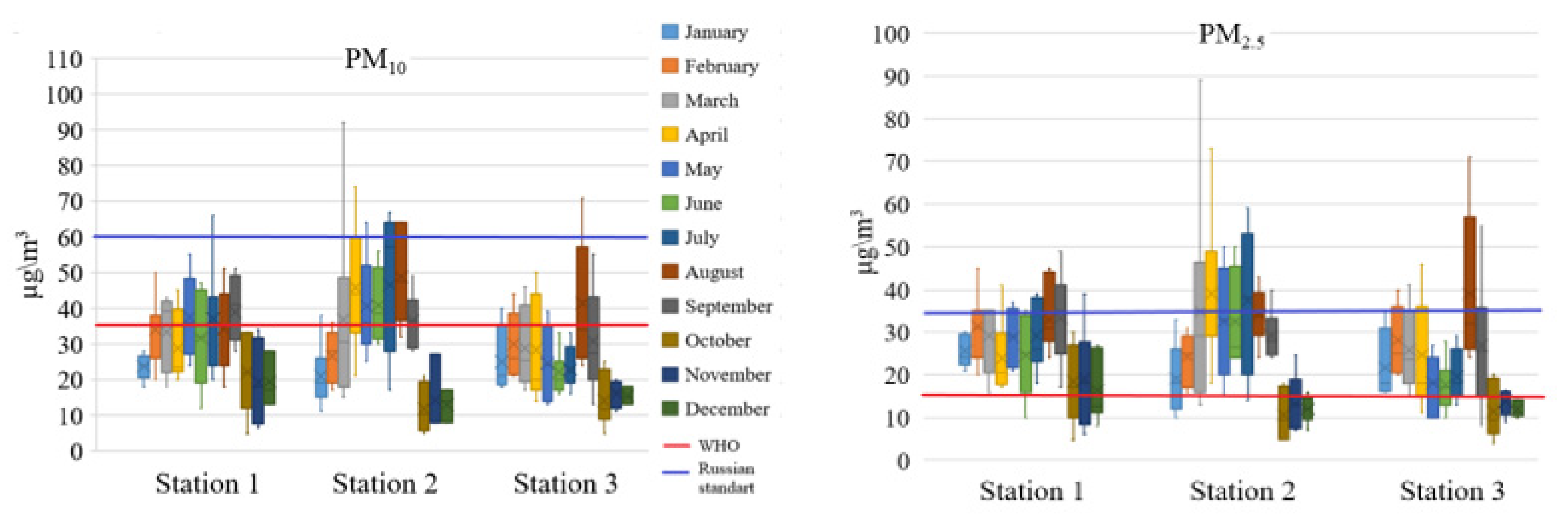
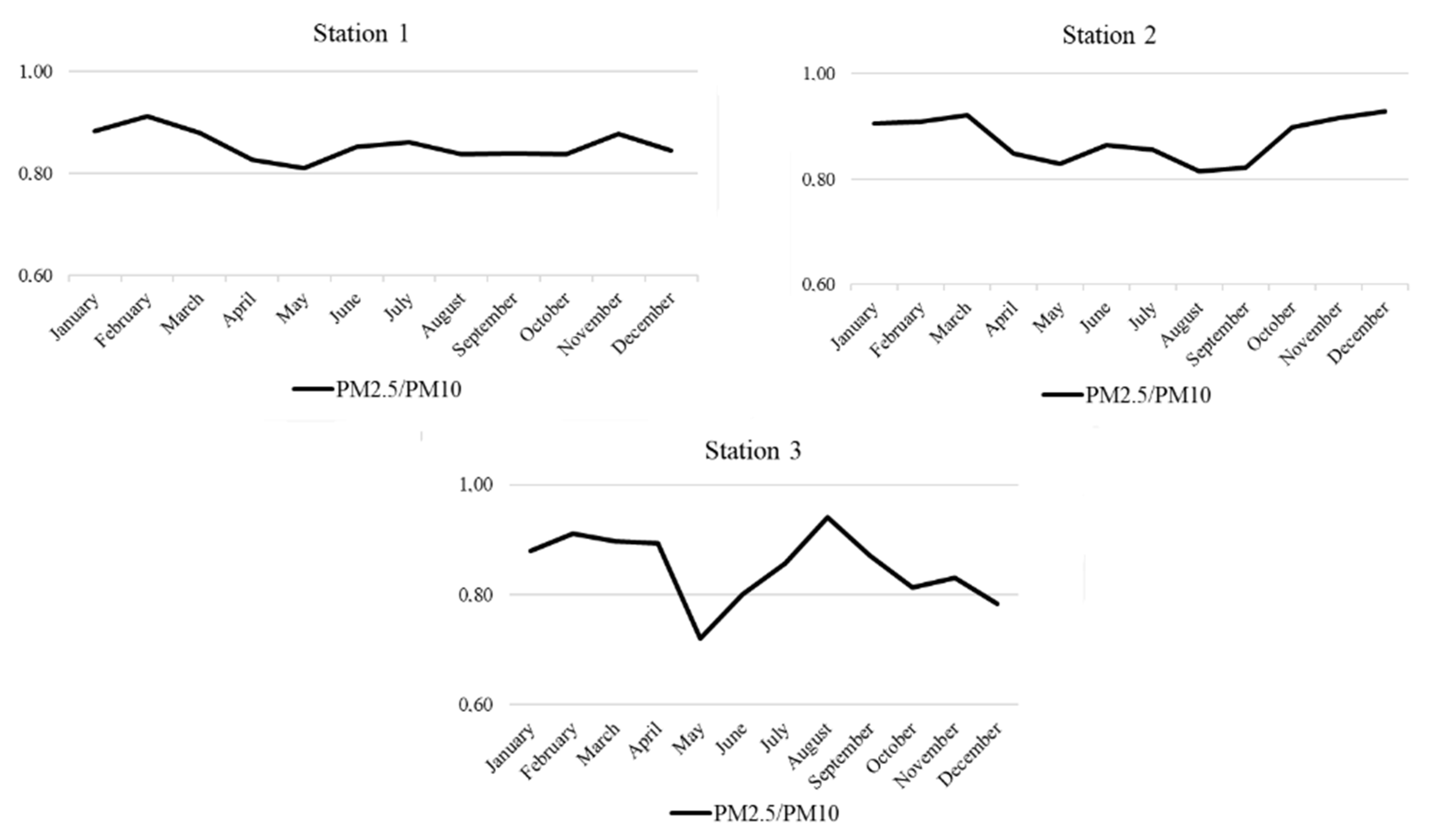
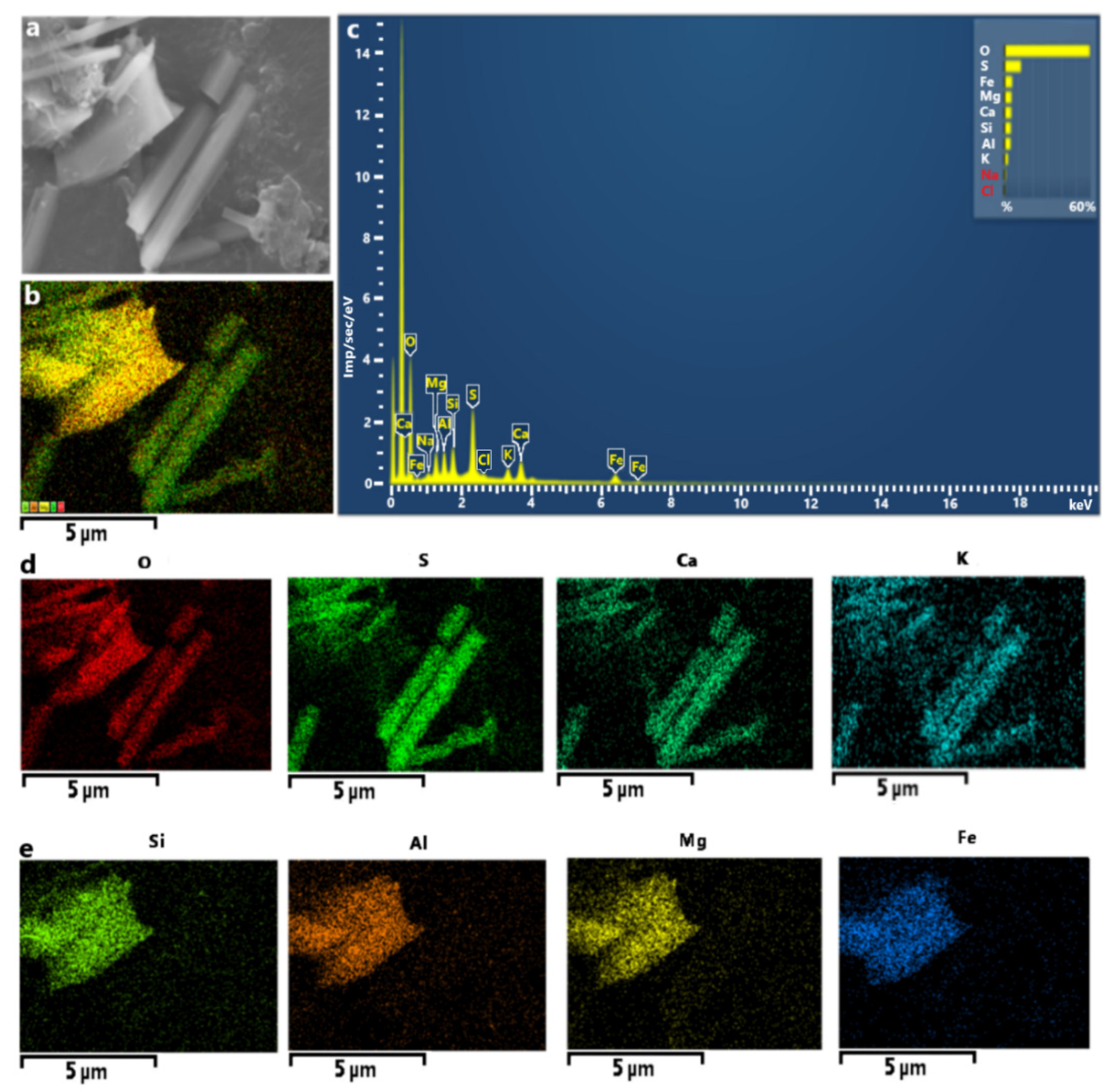
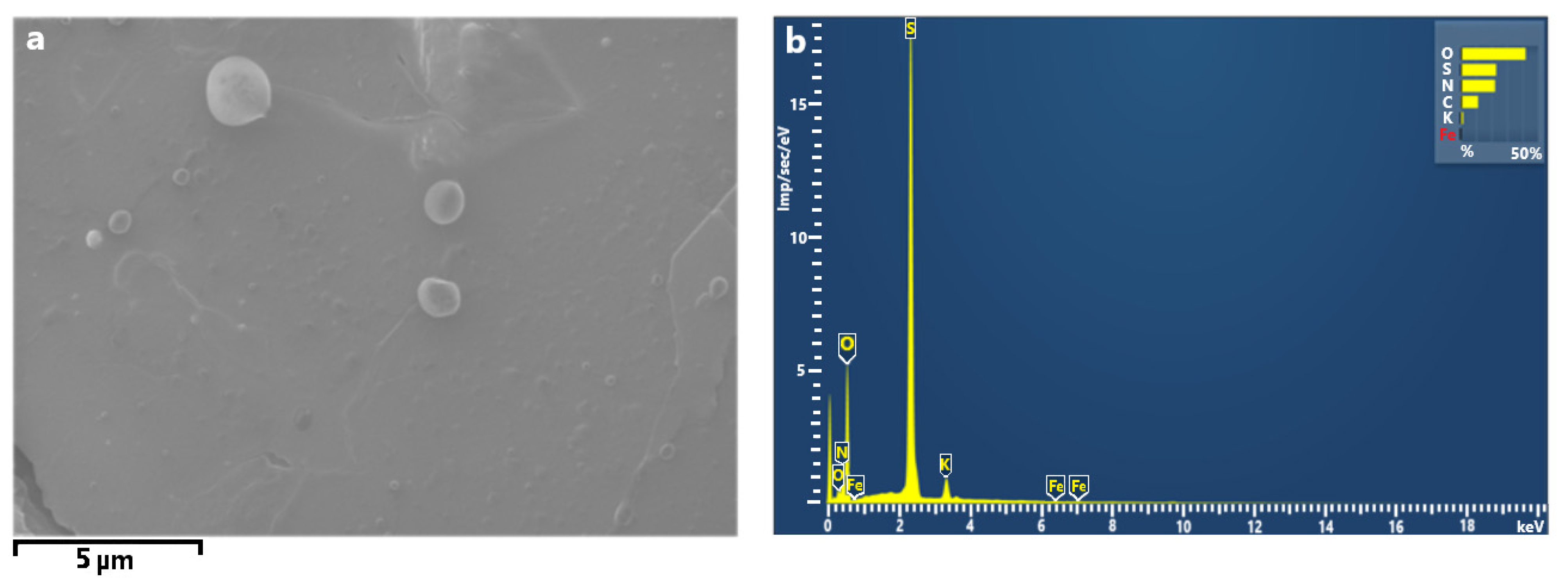
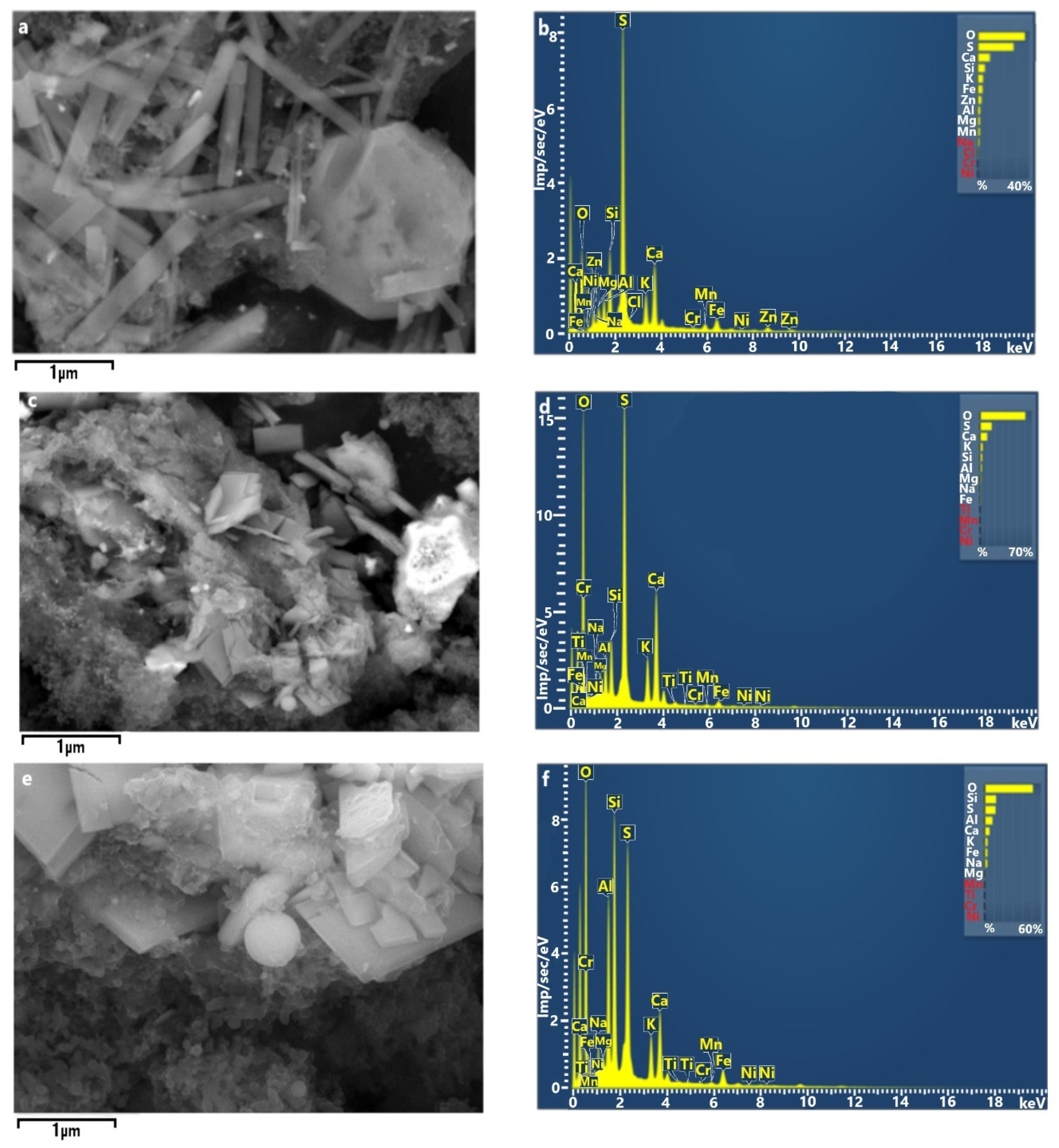
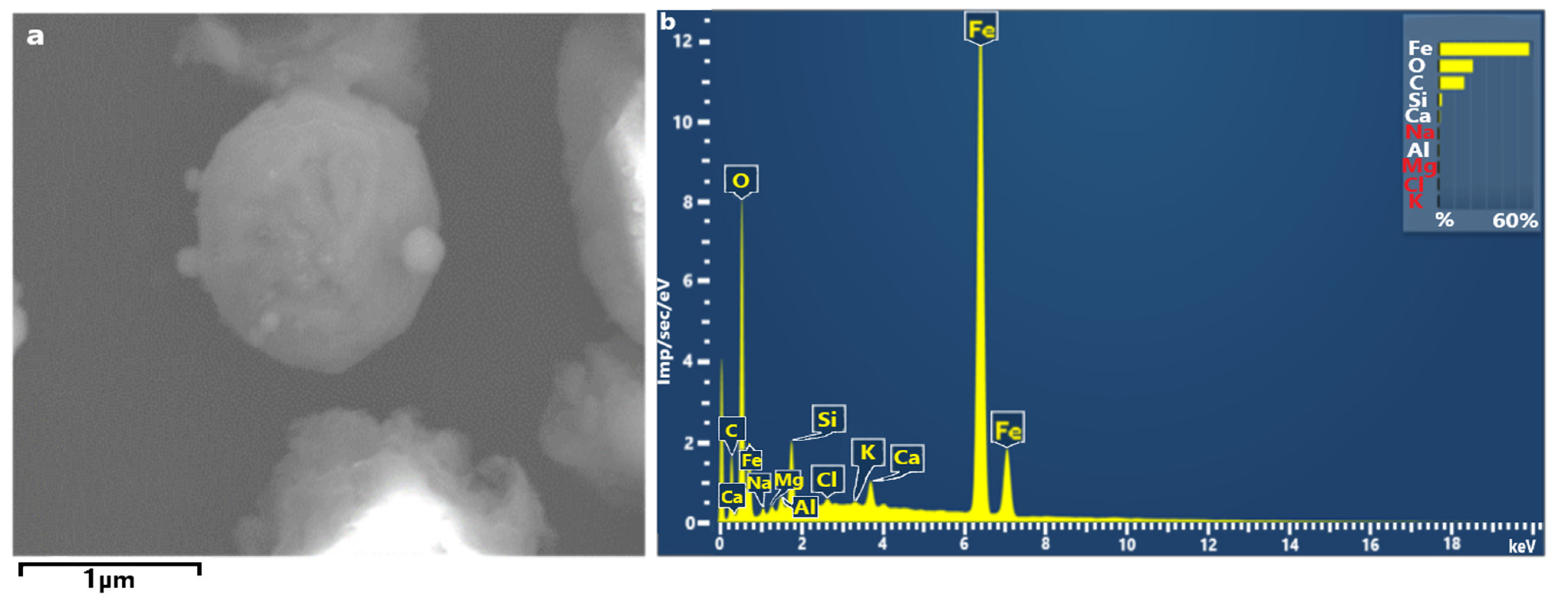
| LOD (ng/m3) | Recovery (%) | |
|---|---|---|
| Al | 0.1 | 97 |
| As | 0.3 | 98 |
| Cd | 0.5 | 109 |
| Co | 0.1 | 98 |
| Cr | 1.1 | 87 |
| Cu | 1.8 | 110 |
| Fe | 1.1 | 105 |
| Mn | 0.4 | 95 |
| Ni | 1.4 | 89 |
| Pb | 4.2 | 119 |
| Zn | 0.1 | 107 |
| Factor | Unit | Value | References | |
|---|---|---|---|---|
| Children | Adults | |||
| EF | days/year | 350 | 350 | [26,28,29] |
| ED | years | 6 | 24 | [22,26,28,29] |
| BW | kg | 15 | 70 | [22,26,28,29,30] |
| ATnon-carc | days | 365 × ED | 365 × ED | [22,28,29,30] |
| ATcarc | days | 365 × 70 | 365 × 70 | [26,28,29] |
| InhR | m3/days | 7.6 | 12.8 | [22,26,28,29,31] |
| PM2.5 | PM10 | |||||
|---|---|---|---|---|---|---|
| Metal(loid) | Station 1 (n = 20) | Station 2 (n = 19) | Station 3 (n = 21) | Station 1 (n = 20) | Station 2 (n = 19) | Station 3 (n = 21) |
| Al | 192 ± 42 | 303 ± 66 | 268 ± 58 | 324 ± 71 | 319 ± 66 | 324 ± 71 |
| As | 9.2 ± 3.6 | 2.2 ± 0.9 | 1.4 ± 0.6 | 9.2 ± 3.9 | 6.1 ± 2.5 | 1.9 ± 0.8 |
| Cd | 1.0 ± 0.4 | 0.7 ± 0.3 | 0.6 ± 0.2 | 1.0 ± 0.5 | 0.6 ± 0.3 | 0.7 ± 0.3 |
| Co | 0.2 ± 0.1 | 0.4 ± 0.1 | 0.4 ± 0.1 | 0.2 ± 0.1 | 0.1 ± 0.1 | 0.4 ± 0.1 |
| Cr | 2.5 ± 0.4 | 3.5 ± 0.6 | 3.0 ± 0.5 | 8.4 ±1.3 | 1.7 ± 0.3 | 3.6 ± 0.6 |
| Cu | 11 ± 2 | 6.5 ± 1.1 | 5.7 ± 1.0 | 13 ±2 | 5.4 ± 0.8 | 8.0 ± 1 |
| Fe | 417 ± 98 | 693 ± 163 | 651 ± 153 | 337 ± 79 | 474 ± 101 | 732 ± 173 |
| Mn | 21 ± 5 | 35 ± 9 | 30 ± 8 | 96 ± 24 | 10 ± 3 | 38 ± 10 |
| Ni | 3.4 ±1.0 | 1.5 ± 0.4 | 1.4 ± 0.4 | 3.2 ± 1.0 | 1.7 ± 0.5 | 1.6 ± 0.5 |
| Pb | 27 ± 5 | 15 ± 3 | 11 ± 2 | 41 ± 9 | 24 ± 5 | 15 ± 3 |
| Zn | 115 ± 19 | 147 ± 25 | 142 ± 21 | 206 ± 34 | 77 ± 12 | 144 ± 24 |
| Area | PM2.5 (24-h Mean) | Al | As | Cd | Co | Cr | Cu | Fe | Mn | Ni | Pb | Zn | Refs |
|---|---|---|---|---|---|---|---|---|---|---|---|---|---|
| Standard Limits | 15 | 6 | 5 | 20 | 50 | [3,52] | |||||||
| Agra (India) | 131–189 | 1388–1688 | 17–35 | 22–26 | 3–4 | 309–354 | 190–210 | 3440–4290 | 58–82 | 61–67 | 320–670 | 319–758 | [53] |
| Nanjing (China) | 281 | 1662 * | 28 * | 8.4 * | 1.6 * | 42 * | 137 * | 1163 * | 123 * | 27 * | 448 * | 878 * | [54] |
| Kanpur (India) | 172 | 109 | 16 | 34 | - | 52 | 627 | 308 | 114 | 7 | 318 | 408 | [55] |
| Chelyabinsk (Russia) | 5–56 | 192–303 | 1.4–9.2 | 0.6–1.0 | 0.2–0.4 | 1.5–3.5 | 5.7–11 | 417–493 | 21–35 | 1.4–3.4 | 11–27 | 115–147 | This study |
| Curitiba (Brazil) | 9.2 * | 1.7 * | 2.2* | 8.05 * | 4.3 * | [56] | |||||||
| Manaus (Brazil) | 9.2 * | 3.1 * | 9.6* | 12.1 * | 19.9 * | [56] | |||||||
| Frankfurt (Germany) | 0.4–1.8 | 0.1–0.8 | 4.4–17 | 13–121 | 4.6–40 | 2.3–10 | 0.6–46 | [57] | |||||
| Salentum Peninsula (Italy) | 6–92 | 1.7–207 | 0.1–13.5 | 0.1–31.3 | 0.9–416.9 | 0.1–8.4 | 0.2–30.4 | 0.9–65.7 | 2.1–154.1 | [58] | |||
| Paris (France) | 33 * | 0.16 * | 3.6 * | 36 * | 128 * | 3.1 * | 1.5 * | 5.6 * | 28 * | [59] | |||
| Athens (Greece) | 1 * | 11 * | 41 * | 1024 * | 19 * | 11 * | 16* | [60] |
| TE | Children | Adults | ||||
|---|---|---|---|---|---|---|
| Station 1 | Station 2 | Station 3 | Station 1 | Station 2 | Station 3 | |
| As | 1.49 × 10−2 | 3.55×10−3 | 2.26 × 10−3 | 5.35 × 10−3 | 1.28 × 10−3 | 0.82 × 10−3 |
| Cd | 4.86 × 10−2 | 3.40 × 10−2 | 2.92 × 10−2 | 1.75 × 10−2 | 1.23 × 10−2 | 1.05 × 10−2 |
| Co | 1.70 × 10−2 | 3.40 × 10−2 | 3.40 × 10−2 | 6.14 × 10−3 | 1.23 × 10−2 | 1.23 × 10−2 |
| Cr | 4.25 × 10−2 | 5.95 × 10−2 | 5.09 × 10−2 | 1.53 × 10−2 | 2.15 × 10−2 | 1.84 × 10−2 |
| Cu | 1.33 × 10−4 | 7.86 × 10−5 | 6.89 × 10−5 | 4.80 × 10−5 | 2.84 × 10−5 | 2.49 × 10−5 |
| Mn | 0.71 | 1.19 | 1.02 | 0.26 | 0.43 | 0.37 |
| Ni | 1.18 × 10−1 | 5.21 × 10−2 | 4.86 × 10−2 | 4.26 × 10−2 | 1.88 × 10−2 | 1.75 × 10−2 |
| Pb | 6.56 × 10−2 | 3.64 × 10−2 | 2.67 × 10−2 | 2.37 × 10−2 | 1.32 × 10−2 | 0.97 × 10−2 |
| Zn | 0.93 × 10−3 | 1.19 × 10−3 | 1.15 × 10−3 | 0.34 × 10−3 | 0.43 × 10−3 | 0.42 × 10−3 |
| Hazard Index (HI) | 1.02 | 1.41 | 1.21 | 0.37 | 0.51 | 0.44 |
| Metals | Children | Adults | ||||
|---|---|---|---|---|---|---|
| Station 1 | Station 2 | Station 3 | Station 1 | Station 2 | Station 3 | |
| As | 5.75 × 10−6 | 1.37 × 10−6 | 8.74 × 10−7 | 8.29 × 10−6 | 1.98 × 10−6 | 1.26 × 10−6 |
| Cd | 2.62 × 10−7 | 1.84 × 10−7 | 1.57 × 10−7 | 3.79 × 10−7 | 2.65 × 10−7 | 2.27 × 10−7 |
| Co | 8.16 × 10−8 | 1.63 × 10−7 | 1.63 × 10−7 | 1.18 × 10−7 | 2.36 × 10−7 | 2.36 × 10−7 |
| Cr (VI) | 4.27 × 10−6 | 5.98 × 10−6 | 5.12 × 10−6 | 6.16 × 10−6 | 8.63 × 10−6 | 7.39 × 10−6 |
| Ni | 1.68 × 10−7 | 7.43 × 10−8 | 6.94 × 10−8 | 2.43 × 10−7 | 1.07 × 10−7 | 1.00 × 10−7 |
| Pb | 4.72 × 10−8 | 2.62 × 10−8 | 1.92 × 10−8 | 6.82 × 10−8 | 3.79 × 10−8 | 2.78 × 10−8 |
| Total risk | 1.06 × 10−5 | 7.80 × 10−6 | 6.41 × 10−6 | 1.53 × 10−5 | 1.13 × 10−5 | 9.25 × 10−6 |
Publisher’s Note: MDPI stays neutral with regard to jurisdictional claims in published maps and institutional affiliations. |
© 2021 by the authors. Licensee MDPI, Basel, Switzerland. This article is an open access article distributed under the terms and conditions of the Creative Commons Attribution (CC BY) license (https://creativecommons.org/licenses/by/4.0/).
Share and Cite
Krupnova, T.G.; Rakova, O.V.; Bondarenko, K.A.; Saifullin, A.F.; Popova, D.A.; Potgieter-Vermaak, S.; Godoi, R.H.M. Elemental Composition of PM2.5 and PM10 and Health Risks Assessment in the Industrial Districts of Chelyabinsk, South Ural Region, Russia. Int. J. Environ. Res. Public Health 2021, 18, 12354. https://doi.org/10.3390/ijerph182312354
Krupnova TG, Rakova OV, Bondarenko KA, Saifullin AF, Popova DA, Potgieter-Vermaak S, Godoi RHM. Elemental Composition of PM2.5 and PM10 and Health Risks Assessment in the Industrial Districts of Chelyabinsk, South Ural Region, Russia. International Journal of Environmental Research and Public Health. 2021; 18(23):12354. https://doi.org/10.3390/ijerph182312354
Chicago/Turabian StyleKrupnova, Tatyana G., Olga V. Rakova, Kirill A. Bondarenko, Artem F. Saifullin, Darya A. Popova, Sanja Potgieter-Vermaak, and Ricardo H. M. Godoi. 2021. "Elemental Composition of PM2.5 and PM10 and Health Risks Assessment in the Industrial Districts of Chelyabinsk, South Ural Region, Russia" International Journal of Environmental Research and Public Health 18, no. 23: 12354. https://doi.org/10.3390/ijerph182312354
APA StyleKrupnova, T. G., Rakova, O. V., Bondarenko, K. A., Saifullin, A. F., Popova, D. A., Potgieter-Vermaak, S., & Godoi, R. H. M. (2021). Elemental Composition of PM2.5 and PM10 and Health Risks Assessment in the Industrial Districts of Chelyabinsk, South Ural Region, Russia. International Journal of Environmental Research and Public Health, 18(23), 12354. https://doi.org/10.3390/ijerph182312354








